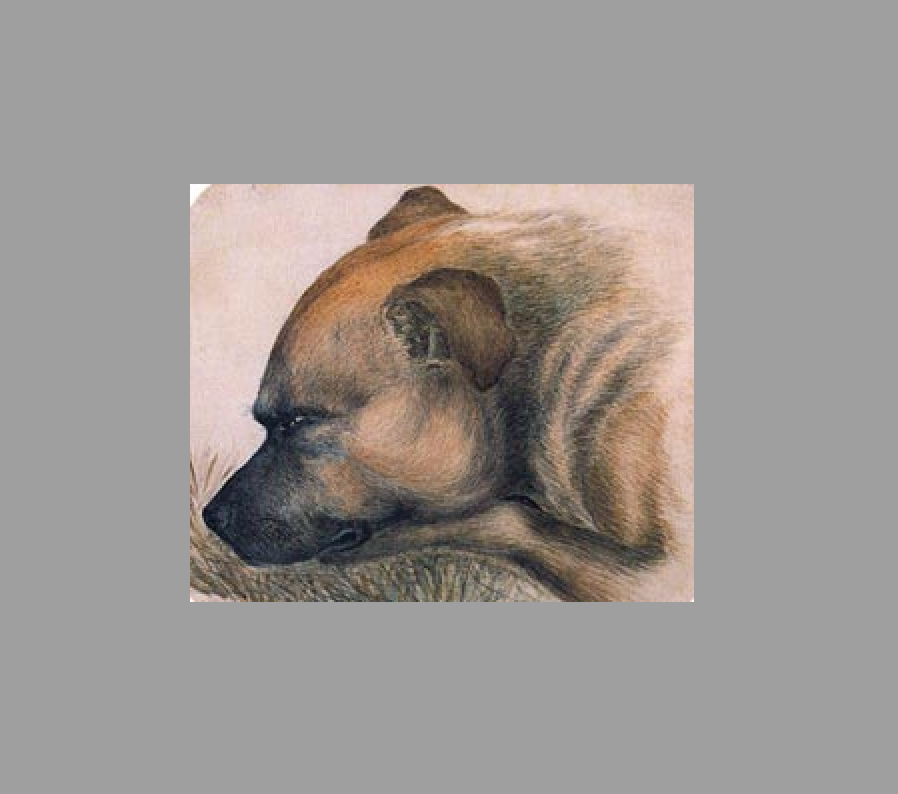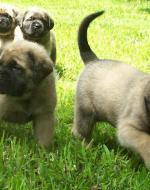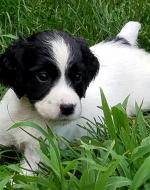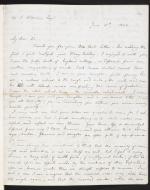Created by Emma Jaeger on Tue, 11/03/2020 - 11:44
Description:
When reading about writers, especially canonical writers, it is rare to find such poignant prevalance of nature as one finds when reviewing the lives and works of the Brontë sisters. From wild Emily to scholarly Charlotte to enduring Anne, the natural world and its inhabitants played a crucial role in the lives of the Brontës and their world views. The most important element of this role, though, was played by the sisters' canine companions. They appear in their biographies and books, over and over again, and they are key to understanding many parts of the sisters' lives and what kept them together, even after only one of them remained. As their protectors, reflectors, and lifelong friends, the beloved dogs cannot be underestimated for the influence on the Brontës, for doing so would be an insult to the sisters themselves.
Keeper, Emily's Favorite
Emily Brontë, Keeper, 1838, watercolour, Brontë Parsonage Museum, Haworth, UK.
"the tawny, strong-limbed ' Keeper, Emily's favourite: he was so completely under her control, she could quite easily make him spring and roar like a lion" - In the Footsteps of the Brontës by Esther A. Chadwick
Keeper, Emily's mastiff mix, was very much like his owner— intelligent, loyal, and loving to a very select few while stand-offish at best to the rest of the world. Emily and Keeper loved each other fiercely, and Ellen Nussey recounted a day on which a sleeping Keeper laid across both her and Emily's laps, and Ellen suffered the extra weight silently to please Emily, who would have surely been affronted had Ellen pushed him aside. Most accounts of Keeper, though, describe him as large and vicious, and in one famous incident, he got in a fight with another large dog. The local men circled to watch the fight, but Emily dove right in-between the two, throwing pepper into the dog's eyes and hauling Keeper away. One can almost imagine the scene—the egging-on of the onlookers while tall, lean Emily thrust herself into the fray with fierce authority, every bit as wild as the two dogs. And let it not be mistaken that Emily's fierce nature was softened by her animals— if anything, perhaps she loved them so much because they were able to match it. On one occassion, after Keeper misbehaved by sleeping on the bed (twice), he growled at Emily as she was dragging him back down the stairs, and in response, she beat him into submission. Of course, such treatment of animals today is known to be ineffective and cruel, but cruelty aside, there is something admirable in the true wildness that seemed to embody Emily's relationship with nature. She had no delusions regarding the windswept moors— she loved them as they were, harsh and violent, and loved Keeper just the same. One of Emily's last acts was to feed Keeper and Flossy, Anne's dog— though she was so weak and light that a wind from the door pushed her over, she refused her sisters' offers of help and fed the dogs.
Flossy, Anne's Favorite
Emily Brontë, Flossy, ca. 1843.
"Flossy — long, silky-haired, black and white ' Flossy ' was Anne's favourite" - In the Footsteps of the Brontës by Esther A. Chadwick
Flossy was given to Anne at Thorp Green as a gift by the Robinsons in June,1843. As with Emily and Keeper, the dog was hardly much different from the owner's person, except for Flossy's inclination for sheep-herding. Gentle and loving Flossy was, most certainly, far more complacent than the abrasive Keeper, but no less loved for it. In May 1849, before leaving for Scarborough— a trip from which she would never return—a dying Anne cradled Flossy close in a heart-wrenching goodbye. Like in most other elements, Anne's gentle, quiet love for her pet goes unnoticed when compared to Emily's passionate bond, but it is no less remarkable or beautiful for its quiet intentness.
Keeper as a Puppy and Flossy as a Puppy
While, obviously, these photos were taken in the 2000s, I think it's important to look at photos like this— of modern versions of things from the past— to ground thinking in reality. It's easy to allow the images of Keeper and Flossy in our minds to be made of pencil marks and paints, but for Emily and Anne, these were living, breathing creatures that they raised—from sweet, soft little pups to strong, sure-footed companions, these animals left their footprints in the Brontë literary canon as surely as on the moors. We see their presence in every Brontë novel, from the dogs in Wuthering Heights (1847) to Sancho and his puppy in Tenant of Wildfell Hall (1848) and even Pilot in Jane Eyre (1847), who is introduced alongside Rochester, despite Charlotte's comparative lack of interest in dogs to her sisters'.
One of Charlotte's Letters to W.S. Williams, 1848 (note— the letter pictured is not the one quoted— that one I could not find pictures of. The letter in the photo was sent in 1848, before Anne's death).
Charlotte's connection to animals did not come until after her sisters passed. Upon returning home after Anne's death, Charlotte recounts in a letter: “The ecstasy of these poor animals when I came in was something singular… I am certain they thought that, as I was returned, my sisters were not far behind – but here my sisters will come no more. Keeper may visit Emily’s little bed-room, as he still does day by day, and Flossy may look wistfully round for Anne – they will never see them again – nor shall I.” After her sisters' deaths, Charlotte wrote Shirley, A Tale in which Shirley and her dog, Tartar, are based strongly on Emily and Keeper. The poignancy of this development is heartwrenching— imagining Charlotte returning home to a house empty besides the animals for which she had never felt much love, but now Keeper and Flossy were the only other living beings who missed her sisters as dearly as she did. With the similarities so strong between the two dogs and their late owners, one can imagine how Charlotte would have grown to see her sisters' in the two dogs, and how, slowly, she would have found comfort and tranquility in the memories they kept alive.
Copyright:
Associated Place(s)
Part of Group:
Featured in Exhibit:
Artist:
- Emily Bronte






